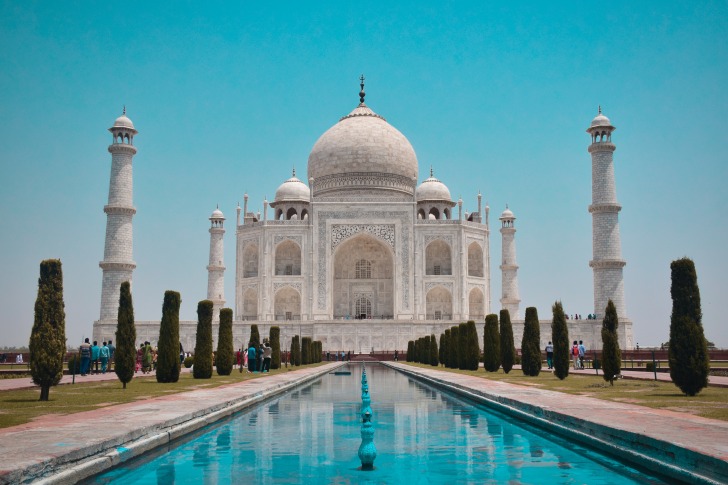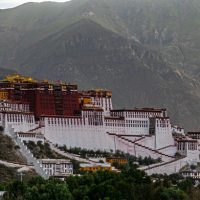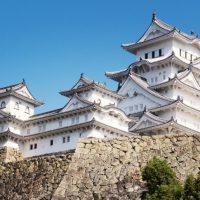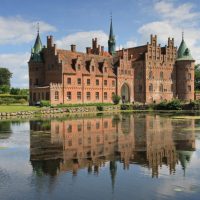India is a third the size in comparison to the US but has more people than any country in the world except for one.
For 65,000 years, people have inhabited the land we call India.
So it’s no surprise they have some of the most astonishing constructions ever seen.
Out of 80 castles still in existence throughout the republic, we’re going to focus on the top 10.
Learning about these Indian landmarks is as much a history lesson as it is a visual treat.
10 Most Beautiful Castles in India
1. Taj Mahal
Most castles are meant to protect an area or be lived in.
This one was meant as a mausoleum.
Mughal emperor Shah Jahan commissioned this palatial remembrance in 1631 in honor of his favorite wife, Mumtaz.
Little did he know, or perhaps he had some clue, that this would become one of the most famous landmarks in all of India.
On 42 acres, the white marble structure sits on the bank of the Yamuna River.
Taj Mahal was mostly finished in 1643 but other parts of the complex continued to be added over the next decade.
It cost ₹32 million to create.
That would be about ₹70 billion or $1 billion nowadays.
There’s more to the Taj Mahal than a resting place, however.
Also on the UNESCO World Heritage Site is a mosque, guest house, and a massive garden.
2. Mysore Palace
After 15 years of construction, Mysore Palace was open for business as of 1912.
When we say business, we mean residence for the family of the Wadiyar Dynasty.
These royals ruled this area of India for centuries.
That makes this estate all the more interesting.
The multitude of dignitaries and events that have been here over the years helped us learn a lot about the past.
The Wadiyar family is still in possession of the palace, which sees six million visitors each year.
Behind the Taj Mahal, Mysore Palace is the most popular place in the country.
Many of those who see it in person continue going back to absorb more detail.
There really is so much to see because of the wide variety of styles incorporated into such a project.
Visual reasons to stop by include colors, a steeple, rounded towers, and a light show after dark.
3. Lakshmi Vilas Palace
Just before the turn of the 20th century, a Raj-era palace was built.
It is actually one of the few examples left in existence.
The ruling Gaekwad family was behind getting the Lakshmi Vilas Palace project off the ground.
As one might imagine, a lot of money was spent on the interior to exude wealth and privilege.
Inside is a highly prized art collection, mosaics, and crystal chandeliers.
This palace is four times the size of Buckingham Palace.
The same royal family is still in possession of the Indo-Saracenic Revival palace.
That doesn’t mean you can’t come to see Lakshmi Vilas Palace in person.
4. Golconda Fort
Prataparudra was a Kaktiya ruler who lived in the 1000s and had Golconda Fort put together with mud.
Around 300 years later, a better fortification was spread out across the area.
Basically, it encompassed the entire village.
Thanks to Golconda’s close proximity to diamond mines, locals experienced a period of plenty.
Sadly, a few hundred years after that, the whole area was taken during an invasion and stripped to the bone.
Unfortunately, the castle’s situation has not changed since.
The ruins are waiting for a final verdict on whether or not they will be considered a UNESCO World Heritage Site.
It’s definitely worth checking out to see the cascading stone frames alone.
5. Amber Fort
It took about 200 years to get everything just right at Amber Fort.
The castle was started by Raja Man Singh in the mid-1500s and the work was completed before 1730.
With all that effort over several different rulers, it’s not surprising that Amber Fort attracts big crowds each year.
Amber has all the ingredients for intrigue, including being placed atop a mountain, near a body of water, and immaculate detail.
As amazing as it is to look at today, one can only imagine what it looked like; brand new and full of activity.
Now owned by the local government, ticket fees help keep Amber Fort up.
It’s also a UNESCO World Heritage Site.
6. Agra Fort
This walled city stretches over 94 acres and was once teeming with life from the comings and goings of its citizens.
During Agra‘s heyday, it was rich and plentiful as the capital.
The fortified structure was used to house pretty much everyone, including Mughal Emperor Akbar and his family.
All that changed in 1638 when the capital was moved to Delhi.
Agra only got to be the castle of dreams for 65 years.
If you’re wondering what was left when everyone left for Delhi, there was quite a bit.
This is great news for archeologists as a way to have some insight into the past.
Still part of the UNESCO World Heritage Site is multiple palaces, banquet halls, monuments, and plenty of personal effects.
Learn more on a walk-through tour.
7. Naggar Castle
Using stones from a forgotten fortress nearby, Raja Sidh Singh put together blueprints for a castle that would last through the ages.
He was even thinking far enough ahead to keep Nagger Castle safe from earthquakes.
The site was complete by 1460 and was the main residence for rulers over the next several centuries.
As of the late 70s, Nagger was converted into a posh hotel.
If you want a view of the Himalayas that would be nearly impossible to find otherwise, this is the place.
In the center of the castle is a courtyard that looks over the valley and out into the scenery.
8. Bangalore Palace
One thing you might not expect to see in the list of Indian castles is Tudor architecture.
King Chamaraja Wadiyar wanted something that more closely resembled what he came across in Great Britain when planning Bangalore Palace.
The king was thinking more along the lines of Windsor Castle.
By 1887, he was ready to unveil his architectural masterpiece.
Made of granite, other design aspects that can be found throughout our Scottish-Gothic accents, Roman arches, and even walls drowning in greenery to emulate the European countryside.
While the outside is reminiscent of another continent, the inside hits closer to home.
Throughout the interior, there is Hindu decor.
9. Zenana Mahal
Construction on Zenana Mahal started towards the beginning of the 1600s.
Referred to as the Queen’s Palace, this castle was the home of the royal harem.
On a deeper level, it was a safe place for women who were considered royalty.
They called it the Ladies Palace and no men were allowed.
It may have been awkward to share a husband with many other women, but these ladies did get to enjoy some of the finer things in life.
In fact, some of the amenities of Zenana were far beyond their time.
One such bonus at the castle is the three types of rooms for seasons.
Each was set up according to the temperature.
For example, a summer room used water to keep cool air circulating.
10. Garh Palace
As a reward for assassinating the ruler, Prince Jait Singh decided to erect a palace on the exact spot of the crime.
Perhaps it was out of guilt that he named the city, Kota, after the one he wronged.
While we may not be clear on the prince’s reasons, he did make the most of the moment.
Garh Palace is similar to a tree in that there are indicators of its age.
With a tree, you’re looking for rings.
In Garh, you’re dating the monuments and art inside.
The palace has been around since the mid-1200s but has aged gracefully.
India Safety Overview
READ THE FULL REPORT: India Safety Review
Safety Index:
- OVERALL RISK: MEDIUM
- TRANSPORT & TAXIS RISK: MEDIUM
- PICKPOCKETS RISK: HIGH
- NATURAL DISASTERS RISK: MEDIUM
- MUGGING RISK: LOW
- TERRORISM RISK: HIGH
- SCAMS RISK: HIGH
- WOMEN TRAVELERS RISK: HIGH
Frequently Asked Questions
What is the biggest castle in India?
Umaid Bhawan Palace in Rajasthan is not only the biggest castle in India, but it’s also one of the largest residences on the planet.
Sprawling across 26 acres, a 15-acre garden, and 70 rooms, Umaid was the last palace built before India became independent from the British.
In total, it took 14 years to complete.
Currently, Umaid Bhawan Palace is home to the royal family, a museum, and a hotel.
Why aren't most of the castles in India called castles?
You can mostly thank the British for this one.
They were called castles at one point and then the British arrived.
While they were making a list of all the castles, they were listed as forts starting in the 1600s through the 1800s.
With that massive time period, it naturally became the most common way to describe structures.
What's the oldest castle in India?
Around 100 CE, the Kushana Dynasty built Qila Mubarak in Bathinda.
As far as we know, it’s the oldest fortress to survive to the present day.
Despite efforts to leave a gaping hole in the structure 900 years later, the government has gone a long way to keep Qila Mubarak intact.
What is the most popular castle in India?
Overlooking the city below is Taj Falaknuma Palace, the most highly regarded castle in India.
Hearing that might make you think it’s like France’s Palace of Versailles, where you can walk up and purchase a ticket.
However, visiting Taj Falaknuma requires much more planning ahead and tickets are only available on the weekend.
Tours are highly regulated and only occur with a chaperone.
Just looking at it from the ground, though, is an awe-inspiring sight.












These castles are truly a testament to the rich history and cultural heritage of India.